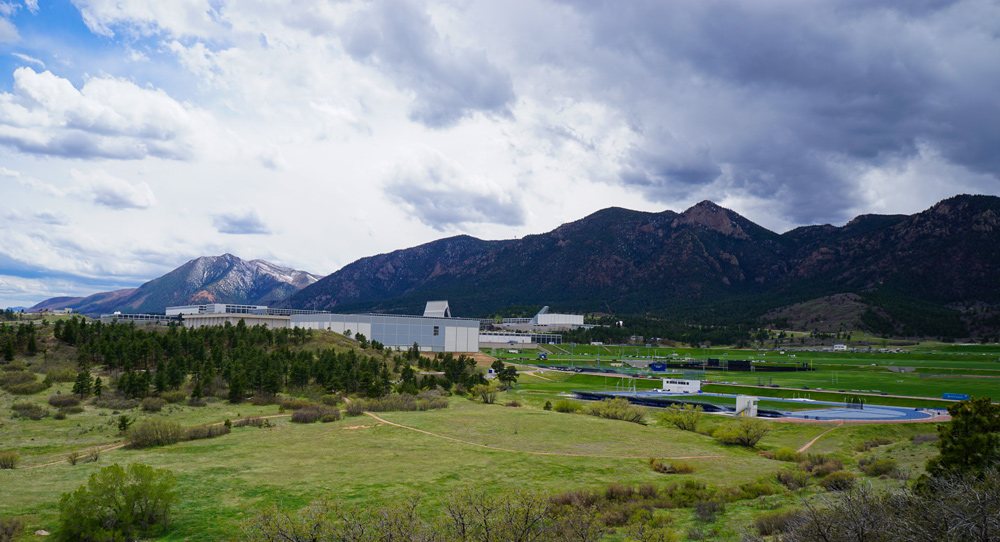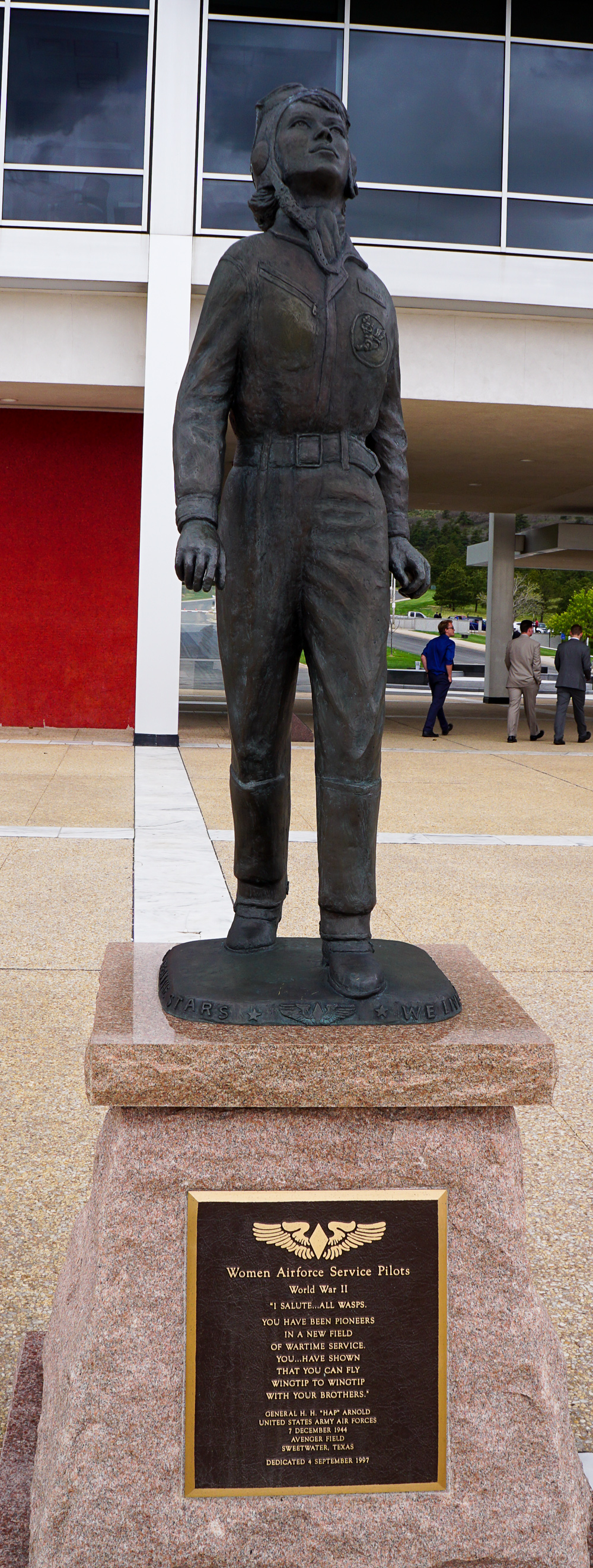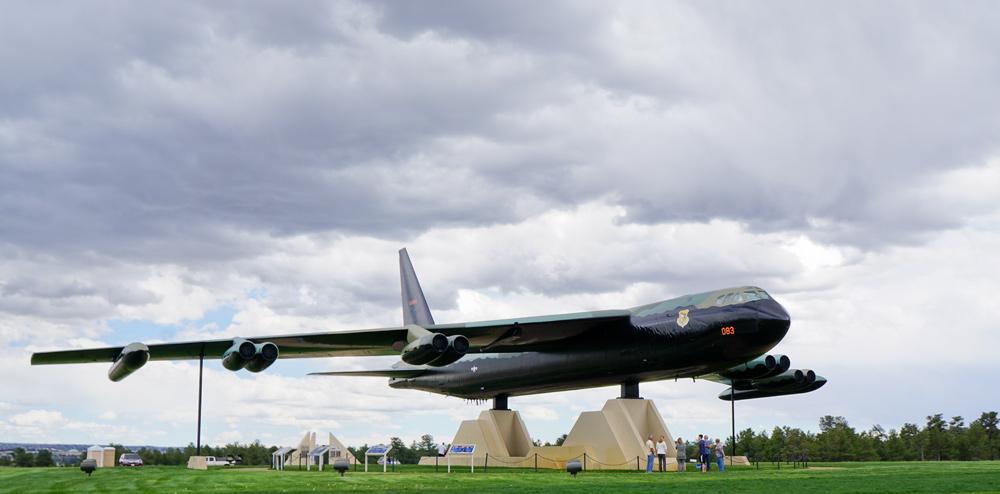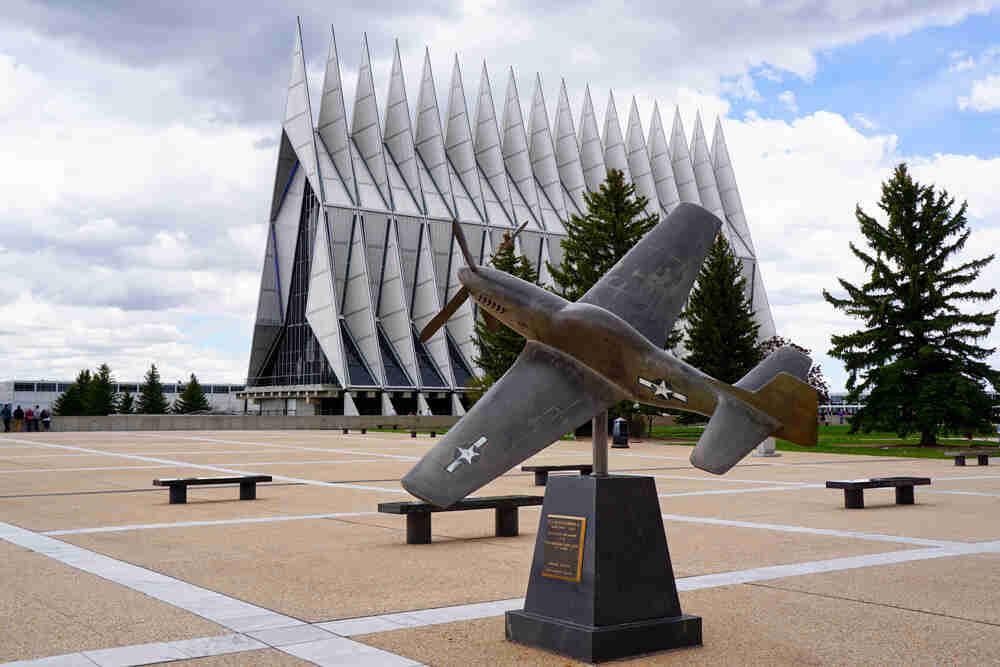United States Air Force Academy
Full Article
 Established in April 1954, the United States Air Force Academy occupies 18,000 acres on the north end of Colorado Springs. It serves as an air force base and undergraduate college for officer candidates. The academy currently enrolls 4,000 cadets as undergraduates, employs 723 faculty members, and serves a community of about 25,000. Military members account for about 470, or 65 percent, of the faculty. Those not directly involved in undergraduate operations include active-duty airmen and women as well as medical, security, fire response, and family care personnel. In addition to cadets, faculty, and staff, the academy welcomes tourists at the Barry Goldwater Visitor Center.
Established in April 1954, the United States Air Force Academy occupies 18,000 acres on the north end of Colorado Springs. It serves as an air force base and undergraduate college for officer candidates. The academy currently enrolls 4,000 cadets as undergraduates, employs 723 faculty members, and serves a community of about 25,000. Military members account for about 470, or 65 percent, of the faculty. Those not directly involved in undergraduate operations include active-duty airmen and women as well as medical, security, fire response, and family care personnel. In addition to cadets, faculty, and staff, the academy welcomes tourists at the Barry Goldwater Visitor Center.
The academy’s sports teams are known as the Air Force Falcons and compete in the Mountain West Division of the National Collegiate Athletic Association (NCAA). During its fiftieth anniversary in 2004, the academy received national historic landmark status. The United States Post Office issued a commemorative stamp, and a historic plaque was installed on the base to honor the designation.
History
The United States Air Force Academy was founded on April 1, 1954, after the air force attained status as a separate service within the military system. Air force enthusiasts saw this as a great victory after years of petitioning for recognition while remaining under the umbrella of military service. At the end of World War II, Colorado Springs faced a small recession, and needed a new industry to boost its economy. This prompted the city’s Chamber of Commerce to form the Military Affairs Committee, with the aim of petitioning the federal government to locate the Air Force Academy in Colorado Springs. Though it initially appeared to be a long shot, several factors led to the committee’s success. President Eisenhower’s wife was from Colorado, and together the couple had spent a lot of time vacationing there. Eisenhower’s affection for the state prompted him to use his political influence to advocate for a Colorado location. Also, the two other top military academies were on the East Coast. As the army sought to gain broader support around the country, it made sense to put an academy somewhere in the West.
The state of Colorado also contributed $1 million to help purchase the land for the academy. Finally, during the Cold War, military personnel believed that the Air Force Academy would be safest from nuclear attack if located in the middle of the US mainland. With hard work and support from local citizens, the Military Affairs Committee eventually succeeded in bringing the Air Force Academy to Colorado Springs.
Gender
 A significant turning point in the history of the academy came in 1975, when President Gerald Ford signed legislation allowing women to attend the nation’s military academies. In 1976, the first female students enrolled in the Air Force Academy. The class of 1980 was the first graduating class to include women. Initially, women only constituted about 10 percent of the cadet class. Today, women make up 19.1 percent of the US Air Force.
A significant turning point in the history of the academy came in 1975, when President Gerald Ford signed legislation allowing women to attend the nation’s military academies. In 1976, the first female students enrolled in the Air Force Academy. The class of 1980 was the first graduating class to include women. Initially, women only constituted about 10 percent of the cadet class. Today, women make up 19.1 percent of the US Air Force.
Though the percentage of women in each class of the Air Force Academy has almost doubled since women were allowed in, the ratio of men to women is still far from 1 to 1. Moreover, women in the academy must face many challenges that men do not. According to one survey in 2003, 12 percent of women graduates were victims of either rape or attempted rape during their tenure at the academy. As recently as February 2015, an annual report card on sexual assault released from the academy stated that 10 percent of female cadets experienced unwanted sexual contact during their schooling. This percentage is likely lower than the national average for college campuses, which stood at 27 percent as of 2006; nevertheless, the statistic demonstrates that the academy is not immune from misogynistic trends in the military and public universities nationwide.
Religious Controversy
Unwanted religious proselytizing also remains a problem at the academy and within the air force. In 2005, one campus chaplain preached that non-Christian students would “burn in the fires of hell” if they did not convert. The academy’s FAQ page maintains, “We will accommodate free exercise of religion and other personal beliefs, as well as freedom of expression,” but as recently as 2010 the academy released a report showing that 41 percent of non-Christian students said they were exposed to unwanted evangelizing during their time at the college.
The air force has also been criticized for a 2013 mandate requiring that airmen and women wishing to reenlist say the words “so help me God” at the end of their enlistment oath. The government is prohibited from requiring religious compliance from service members under Clause 3, Article VI of the US Constitution, which states that “no religious test shall ever be required as a Qualification to any Office or public Trust under the United States.” On September 11, 2014, the Military Religious Freedom Foundation (MRFF), a nonprofit organization that works to protect military members’ religious freedom, sent a letter to US Secretary of Defense Chuck Hagel asking him to strike down the air force’s religious requirement. Seven days later, the air force adjusted its policy, allowing nonreligious cadets to omit the words “so help me God” from the enlistment oath. Though the policy change met the demands of the Colorado Springs-based MRFF, it was apparently driven by another letter written by the American Humanists’ Association. The letter defended an atheist airmen in Nevada who had been denied reenlistment because he refused to say “so help me God” in his oath.
Tension persists today between the academy’s evangelical Christian leanings and its mission of training a diverse group of cadets. In March 2015, US Representative Sam Johnson, a retired air force colonel and Republican from Texas, introduced H.R. 1425, a bill that would reestablish the air force’s religious oath requirement. The bill, as well as the evangelical presence on campus, continues to generate controversy in the air force and Colorado Springs communities.
Cadet Chapel
While there is evidence that religious proselytizing is disrupting student life at the college, the Academy’s Cadet Chapel remains a symbol of inclusiveness. The all-faith chapel includes spaces for various religions and denominations and also houses multiple interfaith spaces—small rooms separate from the denominational chapels. The largest chapel is the Protestant chapel, which occupies the most space and the entire top floor. There is a smaller Catholic chapel below this, with even smaller Jewish and Buddhist chapels rounding out the lower level. The building has historically hosted many annual religious ceremonies and celebrations in all of its chapels and continues to represent the various religious communities in Colorado with many free and open events.
 The chapel is also studied for its architecture and admired for its aesthetics. The principal architect hired to design the famous building in the late 1950s was Walter A. Netsch, Jr., from Chicago. Working with the firm Skidmore, Owings, and Merrill, Netsch completed the building in 1963. The building continues to be renowned globally for its architectural innovation, and retains sleek lines with an emphasis on glass and cement elements. In addition to being added to the registry of historic landmarks, it won the Twenty-Five Year Award from the American Institute of Architects in 1996. The chapel continues to be an integral part of the Air Force Academy, functioning as both a spiritual and community center.
The chapel is also studied for its architecture and admired for its aesthetics. The principal architect hired to design the famous building in the late 1950s was Walter A. Netsch, Jr., from Chicago. Working with the firm Skidmore, Owings, and Merrill, Netsch completed the building in 1963. The building continues to be renowned globally for its architectural innovation, and retains sleek lines with an emphasis on glass and cement elements. In addition to being added to the registry of historic landmarks, it won the Twenty-Five Year Award from the American Institute of Architects in 1996. The chapel continues to be an integral part of the Air Force Academy, functioning as both a spiritual and community center.
Modern Operations
Currently, students in the Air Force Academy are organized into squadrons. There are forty squadrons with 100 cadets each, making up the student body of 4,000. Cadet squadrons each have an air force commanding trainer and two academy military trainers permanently assigned to them, and each squadron includes cadets from all four years of the program. Cadets are required to compete in intercollegiate or intramural athletics each semester, as well as undergo Basic Cadet Training over the summer before beginning their first year to help them transition from civilian to military life. All cadets receive character development training during their time at the academy and commonly spend time volunteering in the community. For example, during the 2012–13 academic year, cadets recorded 38,000 volunteer hours.







